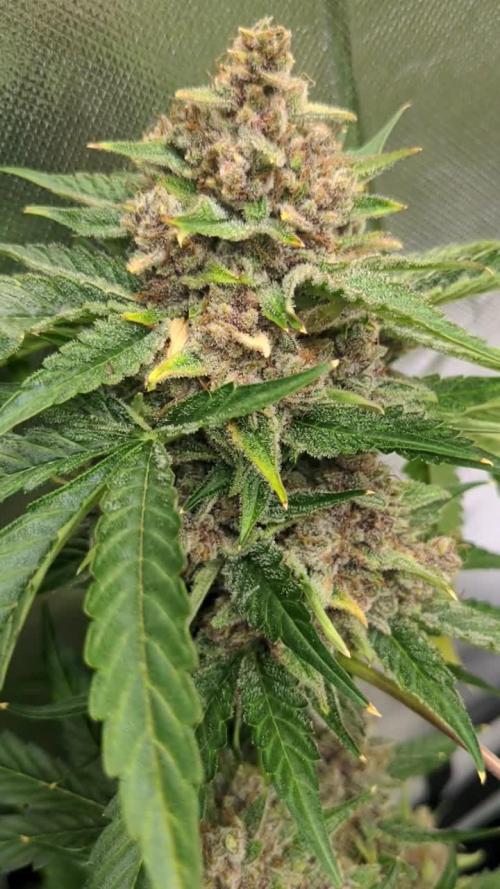The Grow Awards 2026 🏆 

































Likes
Comments
Share


@Glen1818
Follow
The first is already peeking out of the ground, the other should follow.
I used Plagron Lightmix.
LED @ 24W
Likes
3
Share


@Nookandplant42o
Follow
It's drinking a lot of water, obviously because of its huge size, smaller doses of nutrients to go little by little, the shape of the tall buds, they're much more resinous with this update, I'm hoping for more time with this one due to its size and little light.
Likes
23
Share


@Horseluisweed
Follow
Teniendo el sustrato preparado con antelación un par de días antes.. nos animamos a germinar, tengo una tremenda ilusión con esta pequeña, me hace muy feliz verla crecer!🌱 Ojalá todo salga bien y pueda acompañarla hasta el final en este precioso viaje 👽❤️🌱
Nos hemos marcado tres objetivos en este cultivo:
1-hacer un cultivo seguro y no ser detectados👮♂️🥇
2-conseguir una cosecha en menos de 2 meses con éxito 🏇🥈
3-gastar la mínima cantidad de recursos posible con el máximo rendimiento posible🤑🌍⚡🥉
Likes
27
Share


@CampaCavallo
Follow
Seconda settimana della piccola 👍🏻
Sta crescendo molto velocemente come previsto! Direi che è ora di trapiantarla nel vaso da 6.5 litri per farla esplodere di gioia💚💪🏻
30.10.23 trapianto => 6,5 litri ✅
... Sul fondo del vaso, questa volta, ho provato a mettere lapillo vulcanico al posto della classica argilla espansa👍🏻
2.11.23 Fertilizzanti ⚗️
Likes
Comments
Share


@FrenchMister
Follow
Starting to Low Stress Training and super cropping some secondaries
Likes
19
Share


@Naujas
Follow
I think it will be really big :) a few leaves are a little brown, I don't know why, but it's not spreading.:) She's a real lady, she keeps getting taller :) like with high heels:)
Likes
79
Share


@Hou_Stone
Follow
This week i flush the roots with tap water ( PPM : 310 , PH : 7.5) after i add water with 0.7 grow powder and 0.1g of Booster PK+ to reach 720PPM and adjust PH to 5.8
----------------------------------------------------
-Daytime temperature: 27°C
-Night temperature: 23°C
-Humidity: 45-65%
-Lamp: Mars Hydro FC3000. intensity 80% at 40cm from the top leaves
-Room: Mars Hydro 100x100x180cm
-Extractor: Mars hydro 402 CFM Max. power 2/10
-Substrate : 70% coco, 25% perlite, 5% vermiculite.
My instagram : https://www.instagram.com/p/CuMhQ_BsjRP/?utm_source=ig_web_copy_link&igshid=MzRlODBiNWFlZA==
Likes
109
Share


@MadeInGermany
Follow
Welcome to the Green House Seeds Company Cup 🏆
Hi everyone 🤗.
The lady WonderPie has developed very well this week :-)
She likes the Green House fertilizer very much, and has got a very nice color 👍😍.
This week all shoots are topped again and placed in the bloom chamber in about 2-3 weeks 😎.
Next week there will be some enhancers :-).
I wish you much fun with the diary, stay healthy 🙏🏻 and let it grow 🌱.
You can buy the Strain Wonder Pie at :
https://greenhouseseeds.nl/
☝️🏼☝️🏼☝️🏼☝️🏼☝️🏼☝️🏼☝️🏼☝️🏼☝️🏼☝️🏼☝️🏼☝️🏼
Green House Seeds Company Cup 🏆
Type:
Wonder Pie
☝️🏼
Genetics:
Wedding Cake x OG Kush
👍😍
Vega lamp: 2 x Todogrow Led
Quantum Board 100 W
💡
Flower Lamp : 2 x Todogrow Led
Cxb 3590 COB 3500 K 205 W
💡💡☝️🏼
Earth: Canna Bio
☝️🏼
Fertilizer: Bio Grow Feeding ( GHSC ) , Enhancer ( GHSC ) , Bio Bloom ( GHSC)
☝️🏼🌱
Water: Osmosis water mixed with normal water (24 hours stale that the chlorine evaporates) to 0.2 EC. Add Cal / Mag to 0.4 Ec Ph with Organic Ph - to 6.0
Likes
17
Share


@HempBorn
Follow
So like I said the next round will be a 10th planet singel round. Next time with a better irrigation. Just waiting to see the full potecial.
Easy to grow, responds well to LST and topping.
THX Ethos for this wonderfull girl.
Likes
6
Share


@GemansGoGreen
Follow
WEEK 2:
The plants are now in the second week of the growth phase and appear very vital.
Plant #3 has recovered significantly and appears very vital.
Plant #1 is not quite as lush green, but at the same time it is the least developed. I think it will make up for the slight nutrient deficit.
I repotted the plants in 6L pots and added 5% FLO (Living Soil Fertilizer). I let the soil develop for 14 days beforehand. Clear mycelia have formed and the soil has a very pleasant forest floor smell.
- Light Power: 40%
- Soil: BioBizz Light Mix + 5% FLO (Living Soil Fertilizer)
- Additives: Dynomyco mycorrhiza granules
Likes
18
Share


@Islandbuds420
Follow
These genetics are insane! They are growing so quickly and the taproots on these girls look beautiful🔥 can't wait to show you more❤️
Likes
6
Share


@colla69
Follow
Everything going well so far, Res change on day 19 + started ScrOG
Day 21 will have the first 12h night.
Need to keep scrogging during the stretch.. but i won't be here -.-
UPDATE:
I will be going away at the and of this week for Approx 14 Days..
Day 25 [f3] I will move the plant to a bigger container so that it has enough water to survive on its own
Likes
10
Share


@Stacy_smokez
Follow
Going well did some defoliating and going to do some more also added to my grows as well deffiecies still present need a ph pen to check everything may switch nutrients next grow as well
Likes
6
Share


@dwotTV
Follow
Kicked the Critical Kush out to let the Lemon AK have the tent to itself to finish. Tall, strong, some yellow leaves think it might be a ph issue, flushing a bit and continuing to trim and monitor, it's not widespread and the plant is otherwise healthy.
Did a little trim and LST on day 48 to help it take up the extra space that is suddenly available.
Likes
Comments
Share


@GroloCup
Follow
This one has the frost, makes me want to bust out the bubble bags and hash her out! Another that's been very simple to grow, easy feeder and not to picky on anything else. Super dense nuggies with that lovely purple hint to them, an ode to her Purple Haze lineage, with a very earthy, almost nutty aroma. Another day or so then I'll swap out the nutes for some flawless finish (10/14) and properly flush her out. I have to bet this one's gonna be an evening indulgence. Please do yourself a favor and visit the HBS site and give Geoff's work a run in your tent, I promise you'll be in awe of his selected crosses from some of the most prestigious breeders out there.
Likes
39
Share


@AestheticGenetics
Follow
5/8/25
Chopped at day 65 of flowering. Will update more soon.
Not sure if the plagron product did much of anything.
Thank you to Zamnesia and Plagron for sponsoring this Grow.
5/9/25 first day/night of drying and temps are at 67.8 and humidity is at 61%
5/12/25 i had left for vacation for the weekend but when i came back the whole house smelled like a dispensary lol and the humidity was down to 55% sadly
but i have it back up to 60% and 67°F. tonight will be day 4 of drying and i suspect theyll be done in the next couple days around day 6 or 7
Eternity Grow Cup 2025 🤙💣🤘
Likes
21
Share


@PabloTheGrower
Follow
What a great strain...definitely surprised me positively. Thank you Exotic Seeds for the opportunity to work with you trying this awsome plant.
It has a steady growth, kinda short and bushy like a lot of plants with strong indica traits
Very dense buds, big ones, fat and resinous. With a LOT of productions all-over the plant. So much thricome production it sparkles white.
Cutes it yesterday (17/12/2023) altough on my opinion it could have 1 more week.
Altough because of the huge problem I had to do it. This grow tent (specially the other plant growing side by side) had a mold issue, bud rot spreading fast. I must have lost about 5
65 grams of wet flower total on the Fat Banana.
When I cuted it 🍓 Strawberry Cola weighted 829 grams it has a lot of defoliation done alredy but I'll trim it 100% when dry.
This is it, thank you all of you growmies for watching this grow. See u guys on the next one.




















